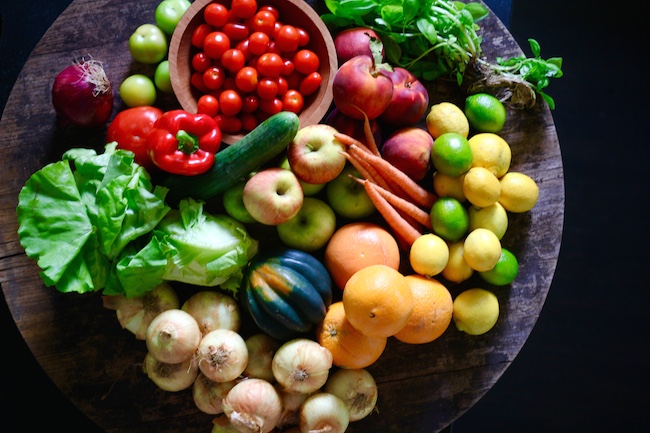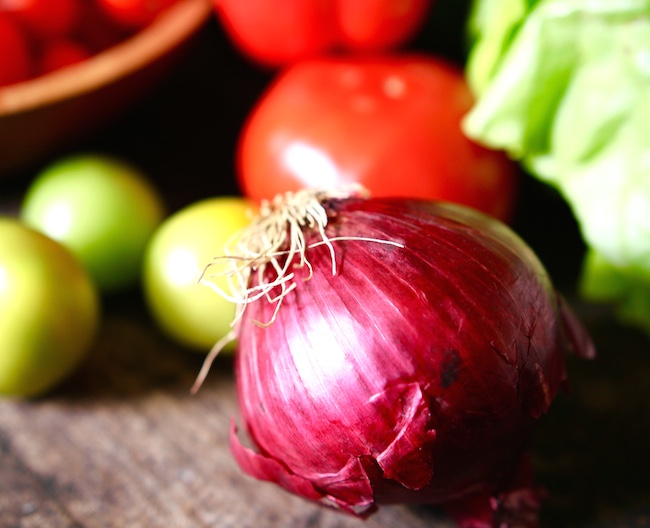When you grow up on a farm you absorb things about food without realizing it, and simply take it for granted that everyone shares the same basic knowledge you do. This post grew out of a surprising conversation I had with some young people who had no idea how to buy produce. This isn’t a comprehensive guide, but more of a tip sheet to skim over before you buy.

Apples: should be firm and crisp, and you shouldn’t be put off by black spots or imperfections if you’re buying organic apples. Apples are at their best from August-November, when they are in season. This is my favorite fruit, but I don’t eat them in the summer (other than the occasional tart Granny Smith) until the new crop is in. Some things really need to be appreciated in their season.
Asparagus: stalks should be firm, never limp, and a bright, strong color. You don’t want the stalks to be too big, because they will lose flavor if left to grow too fat.
Brussels sprouts: should be bright green – with no brown edges on the leaves – tightly packed, and if possible, still attached to the stalk on which they were grown.
Cauliflower: should be well-packed together and not brown on the flowerets. The leaves surrounding the cauliflower should look fresh, green, and healthy.
Cherries: should be firm, without mushy or brown spots.
Corn: should not be refrigerated. The cold changes its chemistry, and therefore the taste. Corn husks should be bright green, the cornsilk soft and not mushy or rotted, and the kernels firm. Corn should be eaten the same day that it’s picked, if possible, and since the flavor of corn is affected by both the soil in which it’s grown and the type of corn seed used, it makes sense to try several different farm market vendors until you find the sweetest, best-tasting corn.

Cucumbers: should be unwaxed, firm, and not yellow in places. The yellow indicates age or overwatering, and neither helps the flavor.
Grapes: should be well-attached to their stems. They stop ripening once picked, so don’t expect a tart bunch to improve with time.
Lettuce: should be crisp and moist, the colors should be bright, and there should be no wilting or rust on the leaves
Melons: should be fragrant, and the best ones that have been allowed to ripen on the vine will have a “ground spot” where they sat on the ground, getting sweet and delicious. If there’s no ground spot, it may have been picked when underripe. You really can tell if a melon’s ripe by thumping it; it should sound like you’re thumping on your diaphragm with your knuckles.
Mushrooms: If you look at the underside of a mushroom cap, the gills should be barely visible. If there are gills that are large and wide, the mushrooms are older than you probably want. They should be firm, without bruises, and have a fresh, earthy fragrance.
Peaches: should be firm but not hard. Dark spots on peaches are not always bruises; sometimes a dark spot is just a place where the sun fell more heavily on the peach and more sugar is concentrated there. Peaches should never be ripened in the refrigerator, but should sit at room temperature for a few days if they’re ripe.
Peas: Peapods should never look as though they’re about to burst open. They should be bright green and moist-looking, and the peas should not be too big. The bigger the pea, the longer it’s been on the vine and the less flavor it will have.
Peppers: should be glossy, firm and bright, without wrinkles (which indicate age).

Raspberries: should be bright-colored and firm. They should not be mushy or pale. If you can find black raspberries – which are not the same as blackberries, and increasingly difficult to get – BUY THEM! They are far and away the sweetest, most flavorful berry, and I can’t understand why more farmers aren’t growing them. Note: they are still widely available in northeastern Ohio.
Rhubarb: Go for the red stalks, not the green, which tend to be stringy, and don’t eat the leaves! They’re poisonous. Rhubarb was our best growing crop on the farm, but we never sold or ate it – because it grew over the septic tank. We just couldn’t…
Strawberries: are also very much affected by the soil in which they’re grown. They are the kind of fruit that stops ripening once it’s picked, as are grapes and melons, so you want to try several different sources until you find the sweetest, firmest strawberries. Smaller berries are usually sweeter, and the color should be bright red; the darker the berry, the older it tends to be.
Tomatoes: should never be refrigerated. The cold changes their chemistry also, and therefore the taste. They should be firm, fragrant and bright-colored, without mushy or soft spots. The flavor of a tomato is affected by the composition of the soil in which it is grown. If you have access to regular farmer’s market vendors, I recommend buying tomatoes from several different vendors to find your favorite tomato, and then sticking with that vendor. Years ago when I lived near Annapolis, I grew tomatoes one summer, expecting the rich, ripe tomatoes I had known in Ohio, and was shocked to find them so acidic that they were barely edible. Different (untended) soil, different tomato.





One Comment